“We have invented nothing.” Picasso, upon seeing the ancient art of the Lascaux caves reportedly came to this disillusioned realization, understanding that art is not modern man’s invention, but a primal instinct. The Lascaux caves, approximated to be over 17,000 years old, are flooded with sophisticated art depicting human handprints and animals—most of which are now extinct—decorating the rocky walls with a relic of a far-gone time. Similar artworks have been found in caves in every continent (excluding Antarctica) dating back to over 45,000 years old and despite its age, cave art, which can be regarded as one of the first known art forms, continues to influence the world of contemporary art.
The Caves
The markings left on the walls of caves across the world leave behind a ghost-like presence haunting the people of today. It is only human nature to be drawn to the caves. The otherworldly art feels almost supernatural due to the incomprehensible time since its creation and the connection it provides to man’s earliest ancestors. With so much intrigue surrounding the caves, it’s no wonder that they have become a subject rich with material to study for theorists, scientists, and philosophers alike. Still, however, mystery surrounds the question as to why the paintings were created. Some theorize that the paintings were made to document and identify predators and prey and could have additionally provided an educational purpose. It is also believed to have held storytelling and entertainment purposes. Much of the cave art is painted in dark areas of the caves, possibly to reveal story elements, using fire to strategically illuminate the paintings to unfold a narrative. Cave art is also believed to have held spiritual or religious significance to its creators. Other theories suggest artistic depictions of animals were created to summon certain species if hunting became sparse, a practice which would seem to work if they were unaware of migration patterns. However no theory can definitively explain why these paintings were created and how though the continents would have no method of communication with each other, similar art is found in each cave: large animals, abstract dots and cross-hatched lines, and hand stencils. Negative hand stencils, created by placing one’s hand on the cave wall and blowing pigment around it with a straw-like tool, leave behind the hand’s imprint. Unidentifiable from one's own, the hands of the first humans stretch through millennia, giving a profound feeling of connection between the people of the present and the people of this other, unreachable world.
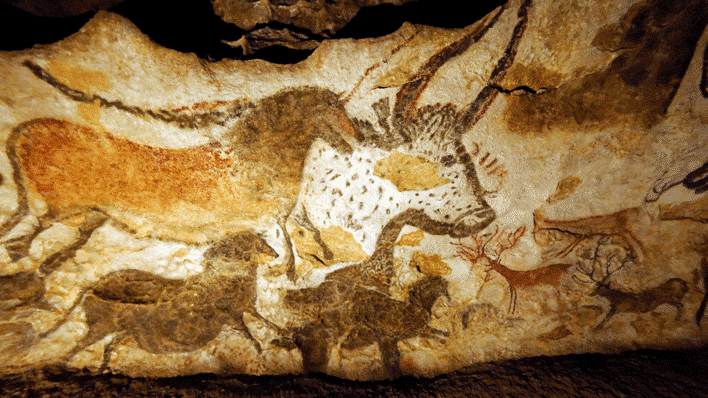
Cave art was created in a time in which all resources must have been allocated for survival yet time was still dedicated to the creation of art. Furthermore, it is evident from the intricate and vast drawings on even the most difficult to access points of the caves that tools and scaffolding were made to aid in the creation of such art, emphasizing the importance they placed on the practice. The natural preservation that caves provide has protected the art from time and nature, giving the people of today the possibility to see them, yet prehistoric artists as they can be called painted much more than caves. Rocks, animal leather, and even themselves are among their many subjects. These focuses make the decision to paint in caves a curious one, as at the time of the artwork’s creation, humans were non-sedentary beings, and painting caves would have proved to be an inconvenient and practically unnecessary process in comparison to their other portable painting surfaces considering the fact that the art would have had to be abandoned. Still, they frequently left their caves painted, likely knowing the art would be preserved, prompting the question of who they left it for. Though more unknown factors could be at play, it is possible that cave art is an example of the inseparable nature of art and humanity, its creation pivotal to the life of the homo sapien void of the need for it to be seen by the eyes of another. It is theorized, however, that they left their art in an attempt to communicate or share information possibly for other groups of people who may wander upon the cave for shelter, or perhaps they were pushed by the familiar desire to leave their mark on the world, hoping that man 45,000 years from now would happen across their handprint and know that they were there.
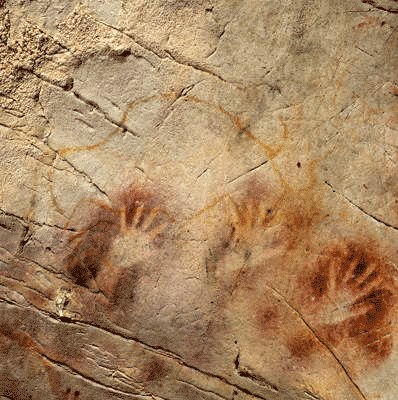
The Influence of Cave Art
Cave art connects contemporary artists with a primal perspective, clearing the clutter of modern life. Inspired by the art of their ancestors, such artists bring elements from pre-historic art to their contemporary works. Moved by prehistoric cave paintings since he was sixteen, Pierre Soulages’ non-representational paintings almost exclusively use black to echo cave art. Influenced first by a reproduction of a 180,000-year-old cave painting of a Bison from Spain’s Altamira cave, Soulages on the topic recalled that “That’s how I started thinking about art. It’s fascinating to think that as soon as man came into existence, he started painting.” Inspired by the choice of a prehistoric man to use black to paint in dark caves, Soulages too uses black, additionally fascinated by the shades ability to change with light, recalling the animated movements of cave art when illuminated with firelight. Animals in cave art often seem to be moving, an illusion created by multiple limbs which become animated in flickering or moving light, additions possibly added by other humans who came across the already painted caves. Uniquely, the element of light is essential to viewing and interpreting cave art due to its lightless environment and the circumstances under which its creators themselves would paint and view the art: through firelight. Soulages uses this concept by working almost entirely with black paint. Soulages is known as “the painter of black” but really, he is a painter of light. "When light is reflected on black, it transforms and transmutes it. It opens a mental field all its own."
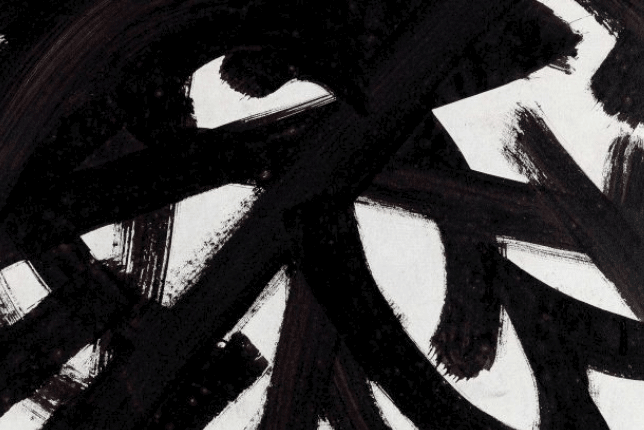
The absence of humans in cave paintings has been an alluring enigma since its discovery. Humans, if painted at all, are depicted without detail as stick-like figures, inferior beside the large and powerful presence of the comparatively detailed paintings of animals. Paleo Archaeologist Jean Clottes concludes: “The essential role played by animals evidently explains the small number of representations of human beings. In the Paleolithic world, humans were not at the center of the stage.” It is only when the creation of cave paintings came to an end approximately 12,000 years ago with the development of early civilizations in the Neolithic Revolution that human faces began to make an appearance in art. Joseph Beuys’ early watercolours shed the human-focused perspective that so much of contemporary art falls prey to and returns the human form to ancient times. With a sensitive eye to form and structure, Beuys paints orange-toned animals reminiscent of cave art along with people among these works of animals with no discernible difference in his depiction. Beuys’ watercolours serve as a humbling reminder of the exaggerated sense of human importance in comparing people to animals with influence from cave art.
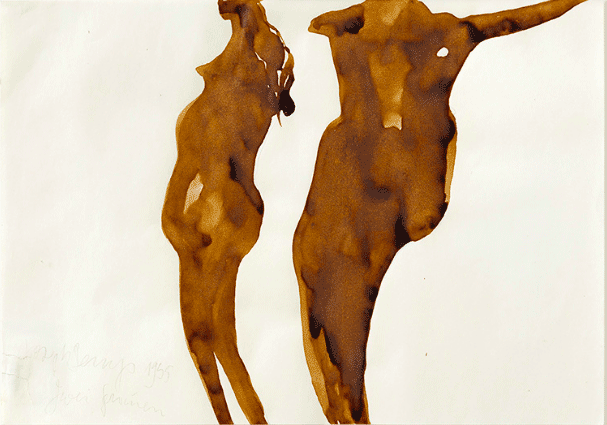
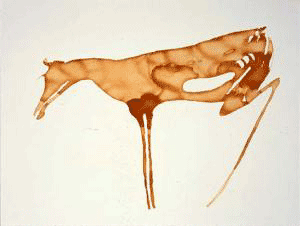
Contemporary Cave Art
The varying forms of art that are left from prehistoric life are oftentimes the only remnants left to decipher it. As the embodiment of a culture, surviving art serves as a window to past lifestyles and societies. Cave art in particular accurately defines its culture to the extent of its abilities as it could have been created by anyone. Since the development of even the earliest civilizations, there has been an attempt to regulate and control art, dictated by the select few elites. Cave art, however, showcases the everyday man, allowing widely seen artistic expression to come from the ordinary person without any known restrictions so that the nameless artist can define the culture of their period. In this sense, cave art is still created today, yet the canvas has evolved from the walls of caves to the walls of buildings.
Graffiti, like cave art, consists of abstract shapes and images created in an attempt to understand and express the external world, both being a crucial element in understanding the time it was created in as well as being masterful artworks in their own right. The controversial art of graffiti acts as an extension of cave art, yet in today’s highly controlled society, this modern cave art is deemed vandalism. Street art is an art form for the non-elite to artistically express and widely communicate socio-political concerns, and erasing such art is openly ignoring its anthropological significance and silencing the voices of the public, an idea one of today’s most infamous graffiti artists, Banksy themselves holds, stating in a 2006 interview: "If our civilization was destroyed, future generations would piece together life in the 21st century using only the scrawlings on our subway walls." The anonymous street artist later created a mural in 2008 emphasizing their views on the topic in which a maintenance worker is power washing away cave art. The unofficially titled, Cave Painting Removal was illegally created in London’s Leake Street tunnel otherwise known as “Banksy Tunnel”, offering a satirical take on art censorship. Here, Banksy asks what qualifies as art, criticizing the elitist art world in which merely a handful of millionaires control what art is and draws the line between art and vandalism. Protecting and preserving cave art is at the highest priority, yet the cave art of today is ignorantly erased along with its anthropological importance if only to uphold an inflated standard of urban purity. In juxtaposing cave art and graffiti, Banksy expresses the value of street art, making the absurdity of its removal all too clear.
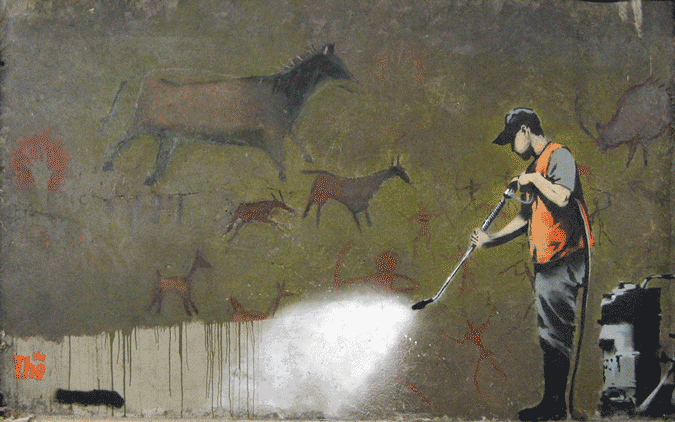
As the descendants of those who can be described as the first artists, it is the responsibility of today’s people to protect and preserve ancient cave art and work to find space for its modern counterpart—street art— so that future generations can understand the present as the generations of today understand the past. Although the true purpose behind cave art may never be revealed, its mere existence strengthens the bonds between modern day people and their earliest ancestors and serves as a beautiful reminder of the essential role art plays in the lives of all humans.
